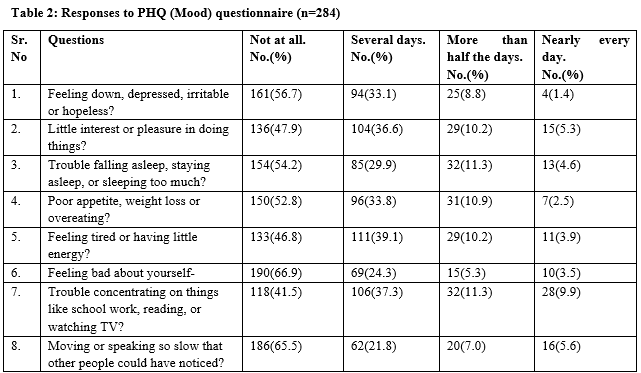Prevalence of depression amongst adolescents in rural area of South India – a school based cross sectional study
Abstract
Introduction:Depression is common in adolescents and especially in high school students and is one of the most frequent mental disorders among teenagers. Depression in adolescents is an under recognized mental health problem because they remain indecisive to disclose their feelings and seldom seek psychiatric help. One of the factors that make depression so difficult to diagnose in adolescents is the common behavioural changes that are normally associated with the hormonal changes of this period. It has only been in recent years that the medical community has acknowledged childhood depression and viewed it as a condition which requires intervention.
Materials and Methods:Aschool based cross-sectional study among adolescents was conducted by using self-administered structured “Patient Health Questionnaire-9 modified for Adolescents (PHQ-A) questionnaire” in rural field practice area of A.J.Instituteof Medical Sciences & Research Center, Mangaluru.
Results:Total 284 students participated in the study and prevalence of depression was 49%. Prevalence of depression increased with age (p-value:0.001) and was higher among females (p-value:0.02).
Discussion:Prevalence of depression in this study matched with other studies conducted in India. Majority of the students suffered from mild depression which indicates early diagnosis is crucial in prevention of progression to moderate and severe forms of depression.
Conclusion:Prevalence of depression among adolescents is high. There is an urgent need for incorporation of simple screening methods for depression in school health program.
Downloads
References
2. Zuckerbrot RA, Jensen PS. Improving recognition of adolescent depression in primary care. Arch Pediatr Adolesc Med. 2006 Jul;160(7):694-704.
3. Centers for Disease Control and Prevention National Center for Injury Prevention and Control. Web-based Injury Statistics Query and Reporting System (WISQARS). Available from http://www.cdc.gov/injury/wisqars/leadingcauses.html accessed on 20/11/2015.
4. Lasaa L, Ayuso-Mateos J.L, Vazquez-Barqueroa J.L, Diez-Manriquea E.J, Dowrickb C.E. The use of the Beck Depression Inventory to screen for depression in the general population: a preliminary analysis. Journal of Affective Disorders. 2000;57(1):261–265.
5. Daryanavard A, Madani A, Mahmoodi M S,Rahimi S, Nourooziyan F, Hosseinpoor M. Prevalence of Depression among High School Students and its Relation to Family Structure. American Journal of Applied Sciences. 2011;8(1):39-44.
6. K Nagendra, D Sanjay, C Gouli, N.K Kalappanavar, C.S Vinod Kumar. Prevalence and association of depression and suicidal tendency among adolescent students. Int Journal of Bio Med and Advance Res. 2012;3(9):714-719.
7. Steinberg, L. Adolescence, 5th ed. New York: McGraw-Hill. 1998.
8. Mohanraj R, Subbaiah K. Prevalence of depressive symptoms among urban adolescents in South India. J. Indian Assoc. Child Adolesc. Ment. Health 2010; 6(2):33-43.
9. Laura P. Richardson, Elizabeth McCauley, David C. Grossman,Carolyn A. McCarty, Julie Richards, Joan E. Russo et al. Evaluation of the Patient Health Questionnaire (PHQ-9)for Detecting Major Depression among Adolescents. Pediatrics.2010 dec;126(6):1117–1123.
10. Chauhan S, Lal P, NayakH.Prevalence of Depression among School Children aged 15 years and above in a Public School in Noida, Uttar Pradesh.Journal of Academia and Industrial Research (JAIR) Volume 2014;3(6):269-273.
11. T GangadharaGoud, Ramesh K, K Pavan Kumar. Factors Associated With Depression among Adolescents. RRJMHS.2014;3(4):73-76.
12. Verma N, Jain M, Roy P. Assessment of Magnitude and Grades of Depression among Adolescents in Raipur City, India. Int. Res. J. Medical Sci. 2014;2(5):10-13.
13. Mohanraj R, Subbaiah K. Prevalence of depressive symptoms among urban adolescents in South India. J. Indian Assoc. Child Adolesc. Ment. Health 2010;6(2):33-43.
14. CompasBE, Oppendisano G, Connor JK. Gender difference in depressive symptoms in adolescents: Comparison of national samples of clinically and non-referred youths. Journal of consulting clinical psychology 1997;65(4):617-626.
15. Kroenke K, Spitzer R, Williams W. The phq-9: validity of a brief severity measures. JGIM 2001, 16:606-616.

Copyright (c) 2016 Author (s). Published by Siddharth Health Research and Social Welfare Society

This work is licensed under a Creative Commons Attribution 4.0 International License.


 OAI - Open Archives Initiative
OAI - Open Archives Initiative


